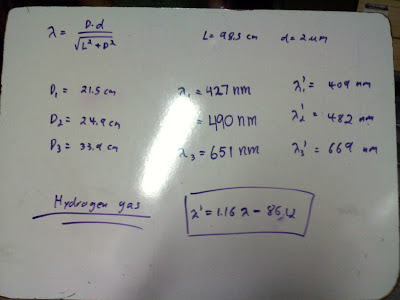Above: The Set up--This set up was used for all cases.
Note two one-meter stick were used and a defraction grating.
The relevant equation used is lambda = D x d/(L^2 +D^2)^(1/2)
where d is fixed and = 500 slits/mm =2 micro meters and L is the distance from the defraction grating to the light source and D is the distance from the color of interest on the light spectrum to the light source.
Part 1:
Note: the uncertainty in all the distances D is +/- .1 cm and the uncertainty for L is +/- 1cm
The data collected for the first experiment is presented in the above photograph. The lambda prime equation is derived essentially from solving two unknowns--the slope and the constant--from two equations: lambda prime = m*lambda+ constant for violet and lambda prime= m*lambda + const for red. For the first equation, the lambda prime is replaced by lowest boundary for violet--roughly 390nm-- in the visible spectrum for humans and the value for lambda is the one that was calculated for the experiment (see above photograph). The same idea is used for the second equation. However this time the highest boundary for red in the visible spectrum for humans is used for lambda prime.
Lambda prime values (nm):
1 = 389 +/- 6.0
2 = 447 +/- 6.5
3 = 540 +/- 7.5
4 = 592 +/- 8.0
5 = 668 +/- 8.8
6 = 749 +/- 9.6 all of these lambda primes are within the uncertainty
Part 2:
For part two, an unknown gas number one was given.
All the data is observed in the above photograph. Moreover, the unknown was determined to be mercury Hg. Only three colors were observed in the spectrum and they were green, yellow-orange-like color, and blue. These values correspond to lambda-1, lambda-2, and lambda-3 respectively in the above photograph. Nonetheless, it was determined that the source was mercury through a reliable internet source that had the visible spectrum of mercury that matched the data in the above photograph.
Part 3:
Note that the uncertainty for D is +/- .1 cm and the uncertainty for L is +/- 1 cm.
There were only three distinct visible lights in the visible spectrum for the hydrogen gas. All the necessary data was found and presented in the above photograph. Moreover, the corresponding energies E-1, E-2, and E-3 are 4.87(10^-19) J, 4.13(10^-19) J, and 2.98(10^-19) Joules respectively.




